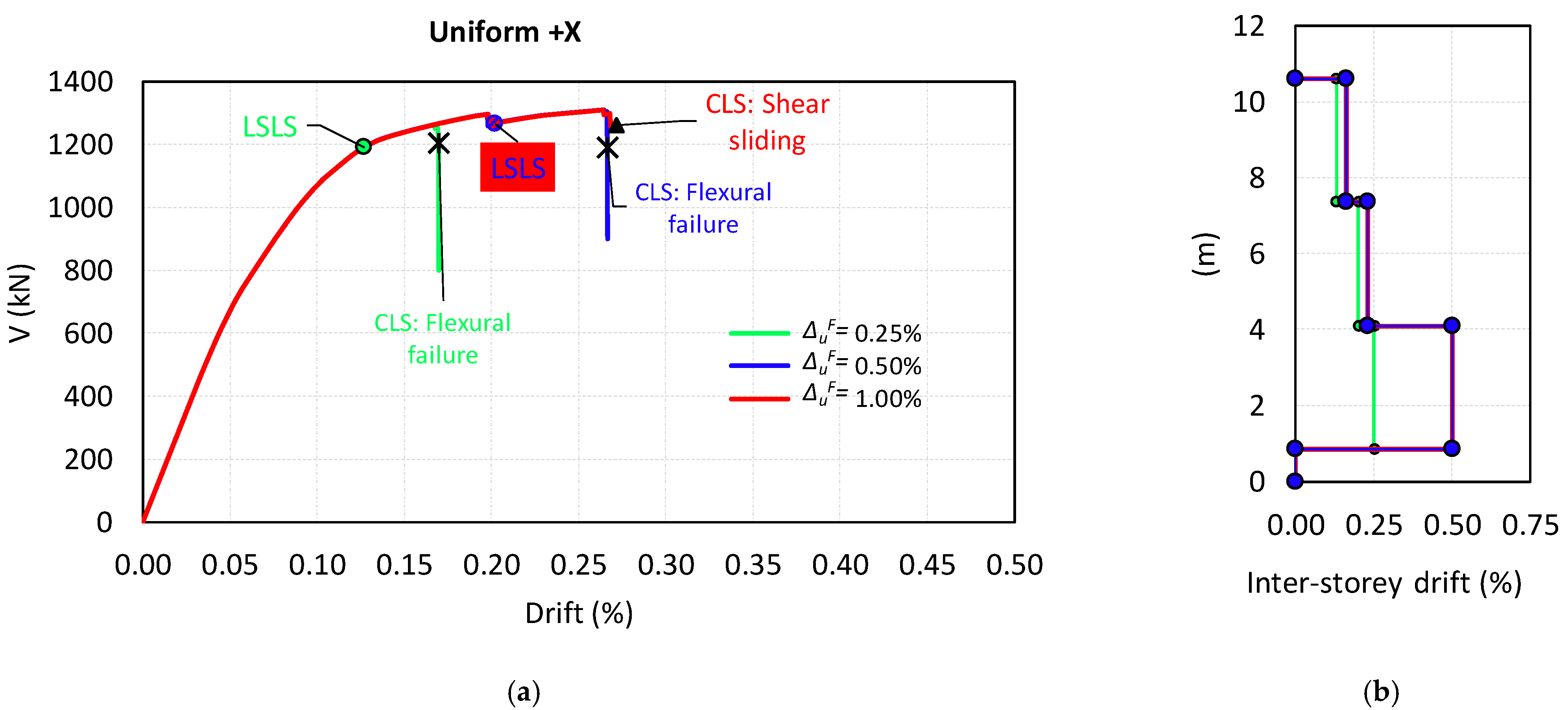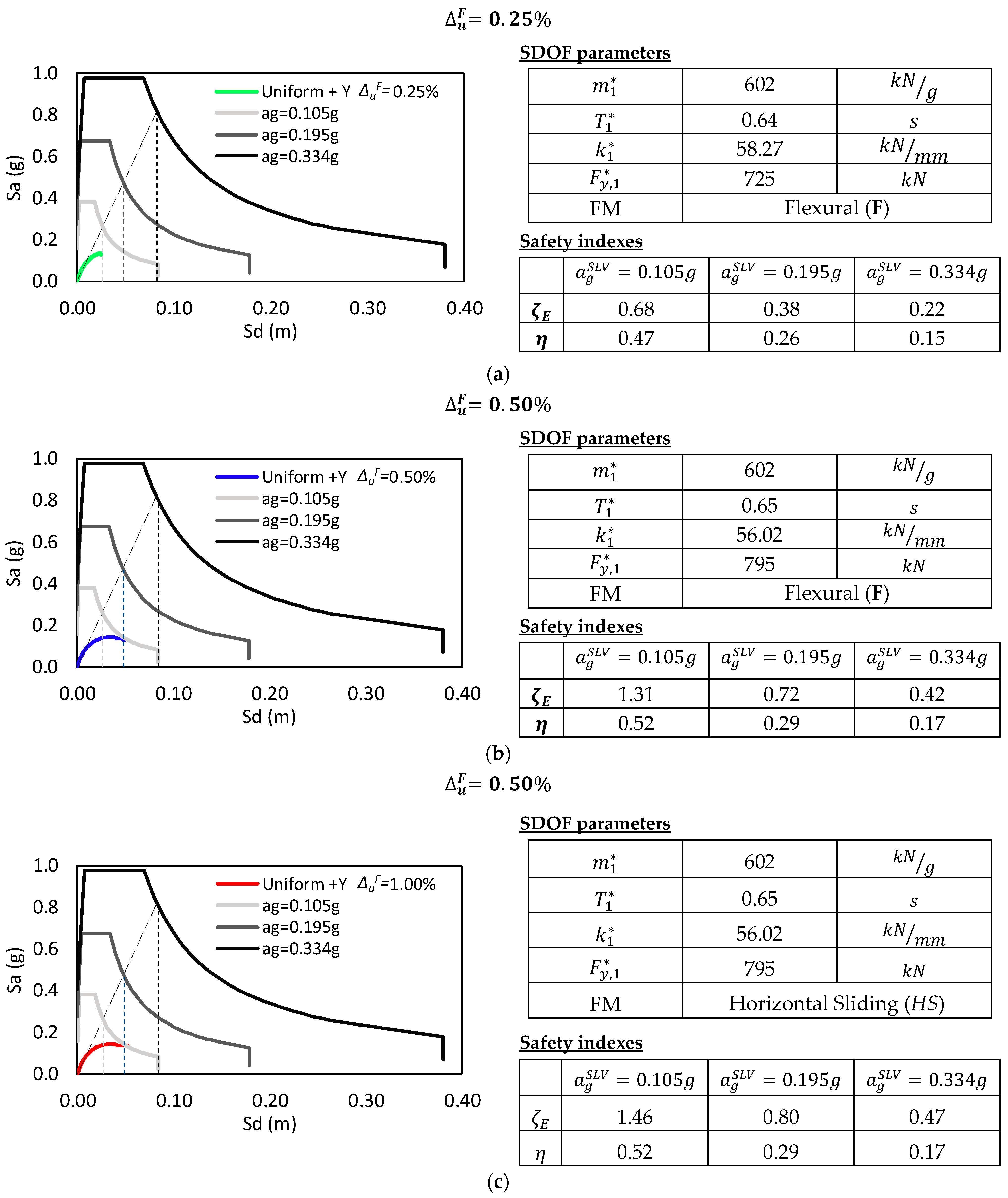Effects of the In-Plane Flexural Behavior Modeling Choices for Hollow Clay Masonry Brickwork with Horizontal Holes
Abstract
:1. Introduction
2. Literature Review on In-Plane Failure Mechanisms of Hollow Clay Brick Masonry Walls with Horizontal Holes
2.1. Uniaxial Compression of Masonry Sub-Assemblies
2.2. In-Plane Horizontal Shear Sliding (HS)
2.3. In-Plane Diagonal Cracking (DC)
2.4. Flexural Panel Crushing (F)
| Element | Property | Symbol [Unit] | Labò et al. [4] | Messali et al. [3] | Canal [1] |
|---|---|---|---|---|---|
| M. assembly: masonry portion | Compressive strength | (MPa) | 1.10 | 1.57 | 1.19 |
| 1.12 | - | - | |||
| 1.45 | - | - | |||
| Elastic modulus | (MPa) | 1100 | 2370 | - | |
| - | - | ||||
| 1400 | - | - | |||
| Compressive strain at collapse | (-) | 0.1% | |||
| 0.1% | |||||
| 0.1% | |||||
| M. assembly: triplet | Initial shear strength | (MPa) | 0.05 | 0.09 | - |
| Shear friction coefficient | (-) | 0.70 | 0.96 | - |
2.5. Mixed Failure Modes
2.6. General Considerations
3. Modeling Choices: Impact of the Reduced In-Plane Flexural Ductility on the Structural Response
3.1. Summary of the Parameters Adopted to Model the Hollow Clay Bricks Masonry Wall
3.1.1. In-Plane Flexural Behavior (F)
3.1.2. Horizontal Sliding (HS)
3.1.3. Diagonal Cracking (DC)
4. Impact of the Modeling Choices through the Application to a Reference Building
4.1. Nonlinear Static Analyses in the As-Built Condition
4.2. Influence of the Modeling Choices on the Seismic Risk Mitigation Strategies
Seismic Vulnerability Indexes of the Building in the As-Built Configuration and the Required Retrofit Stiffness
- (1)
- The ultimate drift of the entire building. For reducing from 1.00% ([10]) to 0.25%, the global drift reduces from 0.27% to 0.17% and from 0.49% to 0.22%, for the x- and y-directions, respectively.
- (2)
- The failure mechanism. By assuming that the ultimate flexural drift is either 0.25% or 0.50%, the collapse mechanism of the building is associated with the flexural failure of the slender piers, while by assuming that is equal to 1.00%, the sliding shear failure of the staircase squat wall occurs. Moreover, it is worth noting that since the aim of the paper was to evaluate the effects of the in-plane flexural behavior modeling choices, a conventional value of 0.4 was considered for the friction coefficient, although the experimental tests showed much higher values (0.70–0.96 in [4] and [3], respectively). The use of such higher values could further shift the failure mode towards brittle flexural failure, in place of sliding failure. Considering that this construction typology does not even resist the vertical loads when the ultimate flexural capacity is reached, the wall-associated failure mechanism is crucial to assess the vulnerability of the building. An incorrect evaluation of the failure mechanisms can lead to quite different considerations on the assessment which could result in disregarding the need to assess stability against the vertical loads.
5. Contributions
- -
- An overestimation of the overall displacement capacity of the building. By reducing the ultimate drift from 1.00% (ordinary masonry walls [10]) to 0.25% (observed in an experimental campaign on slender walls with horizontal holes [4]), the global drift capacity reduces by 37% and 55% in x- and y-directions, respectively.
- -
- A wrong assessment of the failure mechanisms of the piers. The use of a reduced ultimate in-plane flexural ductility shifts the failure mode towards brittle flexural failure, in place of sliding failure. Such an aspect becomes crucial since slender walls with horizontal holes can no longer withstand vertical loads once their ultimate in-plane flexural capacity is reached.
- -
- Defining the design targets (e.g., to guarantee life safety and avoid excessive damage to structural and non-structural components). To avoid failure of slender walls with horizontal holes an ultimate drift target lower than 0.25% must be considered in place of 1.00% proposed by the current code for ordinary masonry walls [10].
- -
- Estimating the minimum stiffness of the retrofit solution, as well as the possible need to retrofit the structure for vertical loads. From the application, it became clear that considering a reduced in-plane flexural ductility (a) in high seismicity areas, the stiffness required to meet the target increased considerably, while (b) in medium-low seismicity areas, the need emerged to introduce a retrofit unlike what was observed considering an ultimate drift compliant with the current codes for ordinary walls.
Author Contributions
Funding
Data Availability Statement
Acknowledgments
Conflicts of Interest
References
- Canal, N. Resistenza Meccanica di Blocchi Forati a Fori Orizzontali; Consorzio Poroton Italia: Verona, Italy, 2006. [Google Scholar]
- Riva, P.; Betelli, E.; Belotti, N. Analisi della Vulnerabilità Sismica di Edifici in Muratura anni’60. Utilizzo di Foratoni Strutturali con Giunti Orizzontali. Prove Sperimentali e Confronto con le Normative Esistenti. Master’s Thesis, University of Bergamo, Bergamo, Italy, 2013. (In Italian). [Google Scholar]
- Messali, F.; Metelli, G.; Plizzari, G. Experimental results on the retrofitting of hollow brick masonry walls with reinforced high performance mortar coatings. Constr. Build. Mater. 2017, 141, 619–630. [Google Scholar] [CrossRef]
- Labò, S.; Marini, A. In-plane flexural behavior of hollow brick masonry walls with horizontal holes. Eng. Struct. 2022, 273, 115086. [Google Scholar] [CrossRef]
- Valluzzi, M.R.; da Porto, F.; Garbin, E.; Panizza, M. Out-of-plane behaviour of infill masonry panels. Mater. Struct. 2014, 47, 2131–2145. [Google Scholar] [CrossRef]
- Tomaževič, M. Some aspects of experimental testing of seismic behavior of masonry walls and models of masonry buildings. ISET J. Earthq. Technol. 2000, 37, 101–117. [Google Scholar]
- EN 1015-11; Methods of Test for Mortar for Masonry-Part 11: Determination of Flexural and Compressive Strength of Hardened Mortar. CEN: Brussels, Belgium, 1999.
- EN 1052-1; Methods of Test for Masonry-Part 1. Determination of Compressive Strength. CEN: Brussels, Belgium, 2001.
- EN 1052-3:2002; Methods of Test for Masonry-Part 3: Determination of Initial Shear Strength. CEN: Brussels, Belgium, 2002.
- NTC. Norme Tecniche per le Costruzioni (NTC 2018); Gazzetta Ufficiale del 20/02/2018, Supplemento Ordinario n.42; NTC: Rome, Italy, 2018. [Google Scholar]
- Giuriani, E.; Regazzi, A.; Luterotti, M. Prove Sperimentali Sulla Capacità di Deformazione di una Muratura Sollecitata a Taglio con Fessurazione Diagonale. Master’s Thesis, Dipartimento di Ingegneria Civile, Architettura, Territorio, Ambiente e Matematica—Università degli Studi di Brescia, Brescia, Italy, 2014. (In Italian). [Google Scholar]
- MidasGEN. Analysis Manual for Midas GEN. 2020. Available online: www.MidasUser.com (accessed on 5 September 2023).
- EC8; Eurocode 8: Design of Structures for Earthquake Resistance. European Committee for Standardization: Brussels, Belgium, 2005.
- Marini, A.; Belleri, A.; Passoni, C.; Feroldi, F.; Giuriani, E. In-plane capacity of existing post-WWII beam-and-clay block floor systems. Bull. Earthq. Eng. 2022, 20, 1655–1683. [Google Scholar] [CrossRef]
- Passoni, C.; Guo, J.; Christopoulos, C.; Marini, A.; Riva, P. Design of dissipative and elastic high-strength exoskeleton solutions for sustainable seismic upgrades of existing RC buildings. Eng. Struct. 2020, 221, 111057. [Google Scholar] [CrossRef]
- Labò, S.; Passoni, C.; Marini, A.; Belleri, A.; Riva, P. Design spectra for the preliminary design of elastic seismic retrofit solution from the outside. In Proceedings of the 7th ECCOMAS Thematic Conference on Computational Methods in Structural Dynamics and Earthquake Engineering—COMPDYN, Crete, Greece, 24–26 June 2019. [Google Scholar]










Disclaimer/Publisher’s Note: The statements, opinions and data contained in all publications are solely those of the individual author(s) and contributor(s) and not of MDPI and/or the editor(s). MDPI and/or the editor(s) disclaim responsibility for any injury to people or property resulting from any ideas, methods, instructions or products referred to in the content. |
© 2023 by the authors. Licensee MDPI, Basel, Switzerland. This article is an open access article distributed under the terms and conditions of the Creative Commons Attribution (CC BY) license (https://creativecommons.org/licenses/by/4.0/).
Share and Cite
Labò, S.; Cademartori, S.; Marini, A. Effects of the In-Plane Flexural Behavior Modeling Choices for Hollow Clay Masonry Brickwork with Horizontal Holes. Buildings 2023, 13, 2438. https://doi.org/10.3390/buildings13102438
Labò S, Cademartori S, Marini A. Effects of the In-Plane Flexural Behavior Modeling Choices for Hollow Clay Masonry Brickwork with Horizontal Holes. Buildings. 2023; 13(10):2438. https://doi.org/10.3390/buildings13102438
Chicago/Turabian StyleLabò, Simone, Stefano Cademartori, and Alessandra Marini. 2023. "Effects of the In-Plane Flexural Behavior Modeling Choices for Hollow Clay Masonry Brickwork with Horizontal Holes" Buildings 13, no. 10: 2438. https://doi.org/10.3390/buildings13102438
APA StyleLabò, S., Cademartori, S., & Marini, A. (2023). Effects of the In-Plane Flexural Behavior Modeling Choices for Hollow Clay Masonry Brickwork with Horizontal Holes. Buildings, 13(10), 2438. https://doi.org/10.3390/buildings13102438







